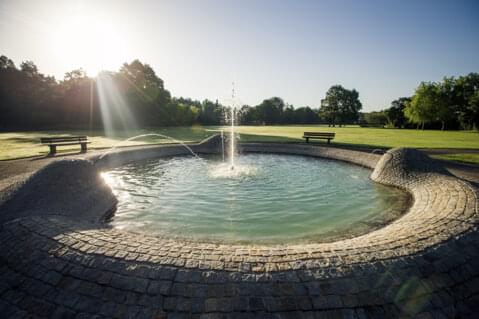History of Bad Füssing
Bad Füssing: They searched for mineral oil - but found a legendary mineral spring instead.
Basic information on the history
"The miracle of Lower Bavaria" or: A gift from nature and part of the Inn valley (the valley beside the river “Inn”). The spa near the town of Passau: At the beginning it was a countrified hamlet with six farmhouses. Today it is a popular spa destination known worldwide, with about 13.500 beds in sanatoria and spa hotels, hotels and private guest houses. The evolution from a small village to one of the largest spas, began a few years ago.

Beginnings and first developments
The development to the spa began before the Second World War, because of a command "straight from the top" to conduct extensive soil research. An authorized institution, represented by the Bavarian mineral oil industry, was in charge of this and made analyses in the area in an attempt to find natural resources; this included experimental boreholes on an acre not far from the hamlet Füssing. At a depth of approximately 1.000 meters, there was no oil or gas to be found, but instead something much better: suddenly, with a pressure of 5.2 atm, hot thermal water, with 56 degrees Celsius and 3.000 liters per minute, rose up to the surface. It was the year of 1938.
The use of this thermal water however, was initially forbidden. The development of Bad Füssing could begin only after 1945, when Carlsbad, Marienbad and Franzensbad were virtually inaccessible for the Germans.
The residents of a nearby foreigners' camp used the thermal water for cleaning purposes. Health officers who supervised this camp were the first to recognize the extraordinary healing power that lies within the thermal water. After reports of numerous healing successes had emerged, the balneology department of the University of Munich built a medically led outpost of the medical-climatologic department in Füssing. In November of 1953 the institution published a report, according to which Füssing's spa is ideally suited for the treatment of paralysis, arthritis, certain skin diseases and rheumatic diseases of muscles and joints.
This expert evidence and especially the enthused statements of the patients, who either found complete healing or at least a relief of their troubles, have made the hot spring famous beyond the borders of Bavaria in a short amount of time.
The rights of use of the hot thermal springs, which originally belonged to the Bavarian mineral oil industry, passed over to a private organization in 1955, called the “Thermalbad Füssing GmbH” (thermal spa Inc.). This organization built more bathing facilities in the same year and also optimized the medical care facilities for the guests. In that year the first spa doctor settled down in Bad Füssing.
The further development of the city was initially slowed down by the community's lack of water supply and sanitation facilities, the lack of admitted building areas and other facilities that are essential for a health resort.
The municipality “Safferstetten” (primeval municipality of Bad Füssing) with 600 inhabitants and its total budget of 40.000 DM was neither administratively nor financially able to provide the needed facilities.
The Free State of Bavaria had become aware of the extraordinary healing results and began to promote Füssing's development.
Initially a carrier had to be found for these duties. The “Zweckverband Bad Füssing” (Bad Füssing purpose association) consisting of the district of Lower Bavaria, the former district of Griesbach and the former municipality “Safferstetten” took over this task in 1958.
Under constant consultation with the local planning authority of the Government of Lower Bavaria, the Supreme Building Authority in the Bavarian State Ministry of the Interior and the famous city planner Prof. Angerer at the Technical University Munich, the community commissioned a development plan. To make this plan become reality, a land consolidation had to be executed first.
At the same time the "Zweckverband" received 27% of the plot area (40 hectares) of the private property owners for free, to use for roads, sidewalks, parking lots and boulevards.
After that, the “Zweckverband” was able to begin the construction of infrastructure facilities, and a first therapy center was opened in 1961.
A further milestone in Füssing's development was the drilling and finding of the second hot spring containing thermal water, by the Free State of Bavaria in 1963 and a further drilling by the doctors “Zwick”.
Thereby, Füssing's supply of healing water had been ensured and it was possible to build more treatment institutions. For example: the spa gardens (with a cost expenditure of 4 millions DM), the small event-hall (“Kleines Kurhaus”) with its music pavilion, the spa-park, lounges and reading rooms.
With the title "Bad" (meaning "bath"/"spa"), which was awarded to Füssing on 10/12/1969, the joint efforts of the public sector and private enterprises in the development of this resort, found the recognition of the Bavarian State Government.
In line with the area reform, on the first of April 1971, the municipalities of “Egglfing”, “Safferstetten” and “Würding” were combined to the new municipality of Bad Füssing, which today counts over 6.300 habitants. On the first of January 1972, a further integration followed, namely “Aigen am Inn”.
In consequence of the attractiveness of the well-known sulfide-sulfur-containing sodium bicarbonate-chloride baths, Bad Füssing also expanded its medical program. Especially medical lectures and similar events quickly deemed the small event-hall (“Kleine Kursaal”) too small. So began the building of the big event hall ("Großes Kurhaus", a building consisting of concert and event rooms, reading rooms, a restaurant, lounges, ...), which was completed and opened to the public in 1980.